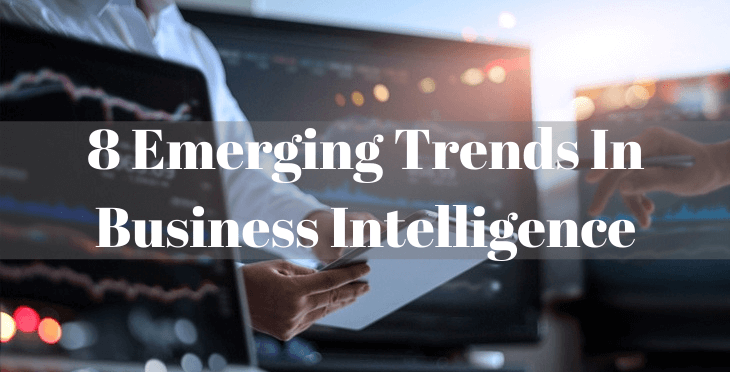There is no doubt that business intelligence (BI) is a trendy topic in most businesses these days. Having already made a mark and revolutionized the decision-making process, BI is at the forefront right now. We have come up with a list of top 8 trends that are sure to define business intelligence in 2023.
Many of BI’s features, like faster reporting, accurate analysis, time-efficiency, and operation efficiency, are making it the most valuable investment for your business.
So, let’s have a look at some of the crucial stats in regard to the usage of business.
- The global business intelligence market is projected to grow from $24.05 billion in 2021 to $43.03 billion in 2028 at a CAGR of 8.7% in 2028.
- As per Allied Market Research, the global mobile BI market will reach $15,990 million by 2023 with a 21.6% CAGR growth rate.
- The market of business intelligence and analytics software combined is expected to grow up to $26.78 billion by 2020.
- A survey taken by Gartner at the end of last year shows that 87% of organizations have low business intelligence and analytics maturity.
After going through the facts, let’s have a look at some of the latest trends in business intelligence.
Top Trends in Business Intelligence
“Customer Analytics” and “Customer Experience” are two of the most crucial trends in business intelligence.
Right from the first purchase to the last action, products or services are taken under consideration to meet the expectations of customers.
Fully functional usage of consumer behavior prediction is an awaited trend in business intelligence.
From emotion detection to speech analytics and customer journey analytics to customer engagement center (CEC) analytics, data from all these analytics reports will become an essential part of business intelligence.
Users’ data is the most valuable and highly secured information that an organization could store as per certain norms and regulation policies.
But, some of the world’s leading brands that only deal with users’ data have started making money from it.
Companies like Google and Facebook are selling our data to third parties for their interest in our personal information (age, sex, demographic info, etc.) and our behavior towards different segments.
So that they could make prediction reports on our surfing and buying behaviors.
Now, you must be thinking this is an illegal practice or ethically wrong.
But trust me, regulated data trade is a profession and could definitely see a hike in the near future.
The year 2020 will be considered as an important year for big data. As data is increasing day-by-day in terms of its volume, velocity, and variety.
The usage of metadata will also be in demand for maintaining and making raw data senseful.
A report by Gartner revealed that by 2020, more than 40% of data science tasks will be performed by machines, robots, or by non-humans. This might not come as a shock for you and me, as we all can see this happening in our present world.
Every known vendor is trying their best to automate their processes right from the inception phase to mass rollouts.
In a way, they are right to do so, as human labor is expensive, and in some complex jobs, they need to focus on saving time and require much more effort.
Machines can be helpful here.
Now, even machines can be expensive on occasions, but because of their better productivity, they can be a wiser option to go for.
Well, the difference between the two lie in terms of their analytics. Demand for analytics is getting higher in the market, and unfortunately, there are not enough skilled people who can fill the gap of reality and the expectation.
Natural language processing brings together computer science, information engineering, artificial intelligence, and linguistics to help computer systems to understand the meaning of human language with context and emotions.
For you and me, understanding and recognizing our language is far too easy, but for a machine, it’s a difficult task.
NLP helps in BI by generating queries and providing an interface to data visualization.
This feature helps users to interact with their data in a structured way.
Today, natural language processing has become an emerging technology in business intelligence.
Most of the vendors are working on this technology for more seamless interaction between humans and machines.
And, how could we forget artificial intelligence while discussing emerging trends of business intelligence? AI & ML is the science that helps machines to learn the complexity of human brains.
As of now, we haven’t observed AI being fully functional in our daily life, but the fact remains that it is bound to affect our lives in some or the other way.
Both, AI and ML are revolutionizing the methods of how we interact with our data management and analytics.
But, AI has been evolving into a key driver that helps business intelligence with decision making business processes.
That day is not far when humans become proficient in “generative adversarial networks.”
To illustrate this, one AI-enabled machine will create a realistic image, and the second one will analyze and determine whether the image is real or artificial.
In many organizations, data scientists often use a very complex tool to create on-demand analytics reports for managers.
But the fact is that these results and report are way too difficult to understand for those who do not have any background in data analytics.
This situation raises a query, but there is a solution. In these scenarios, the need for narrative data-driven has arrived.
Data is now segregated into two parts (interpretation and contextualization), although the result will remain the same, the presentation of data will change.
This practice will help the users to comprehend the analytics reports without putting in much effort.
This entire process is also known as data storytelling. Nowadays, many known organizations are working on this concept to make it fully functional.
Businesses around the globe have started realizing that a good data strategy can significantly improve their investment in business intelligence.
Anyhow, these days you cannot rely on one source of data or information for your business. Whether you own a small enterprise or a big one, your data will increase day by day.
And, as your data continuously increases, it becomes that much more complex and thus the need for data management will arise.
In the past few years, we have witnessed some of the worst data breaches incidents, and this has bought data governance to the forefront.
Data governance will ensure that the authority of accessing data will remain with only certified people of your organization.
These certified people will also be known as data administrators, and these are the only ones who will be responsible for sharing and transferring data from one user to another.
You May Also Like to Read:
10 Key Steps for Business Intelligence Implementation
7 Keys to a Successful Business intelligence Strategy
Current trends in Business Intelligence and Analytics
Business Intelligence Tech Trends and Real-World Applications






